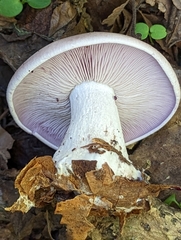This website allows you to see lists of mushrooms organized by where they are found in Nebraska parks. Links from the below identification key will direct you to different lists of mushrooms that have been surveyed in Nebraska parks. For more advanced queries, please see the website manual.
Key to Major Forms
To identify a mushroom, start here. Does your mushroom match the form? If so, click on the "list" link. If it doesn't continue on down the list. If you can't find the form of your mushroom, please look in "non-typical" forms. Keep in mind that fungi forms often overlap and commonly fit into multiple categories.
Gilled Mushrooms. aka Agarics

These mushrooms typically have a stem that raises the cap above the substrate. Underneath the cap are a multitude of flat plates called "gills" that radiate from the stem outwards to the cap margin. The surface of these plates generate spores which promote the reproductive cycle of the mushroom species.
Boletes

These mushrooms have a cap and stem and are generally soft, stout, and fleshy. Underneath the cap is a layer of tubes that can be easily separated from the cap in most species.
Chantrelles

These are trumpet-shaped mushrooms. Although they appear to have gills at first glance, the spore producing surface is not easily separatable from the cap and stem, and are actually folding structures rather than true gills. Many are delicious edibles.
Polypores

These mushrooms have pores on the underside of the cap (polypore = "many pores") and generally grow on wood. THe pore surface is generally not separatable from the cap and many species are quite tough. Polypores take can take additional descriptive forms, including conks, shelves, rosettes, and crusts.
Conks

Conks usually have a stem, are usually stout, growing on wood, commonly hard perannials. They can have pores, teeth, and sometimes hard, mock gills. Pores can be round, oblonged, angular, or maze-like.
Shelf

Shelving fungi commonly grow in large groups, have pores or teeth on the underside, and grow on wood.
Crust

Crust fungi are found growing flat against a surface, generally a downed tree. Pores may be visible. They may also be smooth, wrinkled, soft, hard, wet, or dry. They come in an array of colors can be easily found in most seasons.
Coral

As the name suggests, this form is reminisant of underwater coral structures, generally branching into separate segments as it grows from the base.
Toothed

These mushrooms have spore bearing surfaces that are a sharp tooth-shape, similar to stalactites on the roof of a cave. They can be almost coral-like as in the Coral Tooth Fungus, shelfing as in Steccherinum subrawakense, or similar in stature to an agaric as in the Hedgehog Mushroom.
Nest

These interesting fungi develop cups (or "nests") with visible packets of spores ("eggs"). Raindrops will fall into the cups and the force and expell the spore packets far away from the parent fruiting body.
Sequestrate (Puffballs, Earthballs, Earthstarts, and Truffles)



These mushrooms produce spores on the inside of their bodies rather than external production. They present themselves as ball, or pear-shaped, and sometimes possess an outer layer that turns into a star shape at the base.
Jelly

These fungi have a gelatinous texture and consistency when fresh, becoming ridgid and brittle when dry.
Lichen

Lichen are generally found on tree bark, rocks, tombstones, old metal, anywhere they can create a crust on. Lichens are actually a combination of organisms of a fungal base for protection and a photosyntehtic organism for food production. Imagine them as small cities where the fungus is farming energy the photobiant.
Slime-mold

Slime molds are not true fungi, althought they appear so in nature. They are aggregations of microsopic organisms with complicated and fascinating lifecycles.
Rust

Rusts can be found infecting leaves or fruit.
A common and unique rust in Nebraska is Juniper-Apple Rust, which has an interesting lifecycle jumping between Apple trees and Junipers as they mature and reproduce. They generate these bizarre, orange, jelly-like structures on Junipers (including "Eastern Red Cedar").


